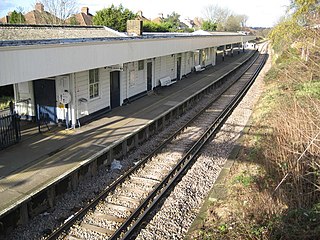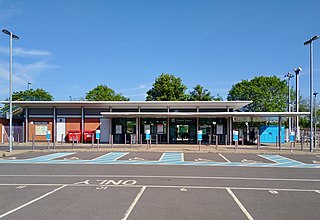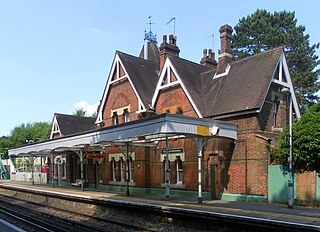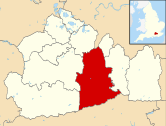- ↑ The Horsham line rejoins the Brighton Main Line-cum-Arun Valley Line at Horsham and at Balham in London; the New Guildford via Epsom line rejoins its via Cobham route at Effingham Junction and at Raynes Park in London
Related Research Articles

Epsom railway station serves the town of Epsom in Surrey, England. It is located off Waterloo Road and is less than two minutes' walk from the town's high street. It is 14 miles 18 chains (22.9 km) down the line from London Waterloo.

Sutton railway station (sometimes referred to as Sutton (Surrey) on tickets and timetables) is in the London Borough of Sutton in South London and is the main station serving the town of Sutton. It is served by Southern and Thameslink trains, and lies in Travelcard Zone 5, 14 miles 75 chains (14.94 miles, 24.04 km) down the line from London Bridge, measured via Forest Hill.

Motspur Park railway station is a suburban station in the London Borough of Merton in south London. The station is served by South Western Railway, and is in Travelcard Zone 4. It is 9 miles 57 chains (15.6 km) down the line from London Waterloo.

Raynes Park railway station serves the district of Raynes Park in the London Borough of Merton. It is 8 miles 51 chains (13.9 km) south-west of London Waterloo and is situated between Wimbledon and New Malden on the South West Main Line. The next station along on the Mole Valley branch line is Motspur Park.

The Sutton and Mole Valley lines were constructed between 1847 and 1868 by the London, Brighton and South Coast Railway, the London and South Western Railway and the LBSCR-sponsored Horsham, Dorking and Leatherhead Railway.

Horsham railway station serves the town of Horsham in West Sussex, England. It is 37 miles 56 chains (60.7 km) down the line from London Bridge, measured via Redhill, on the Arun Valley Line and the Sutton & Mole Valley Lines, and train services are provided by Southern and Thameslink. Services on the Sutton & Mole Valley Line from London Victoria via Dorking terminate here, as do Thameslink services from Peterborough via London Bridge. The other services continue into the Arun Valley: a half-hourly service from London Victoria to Bognor Regis, and a half-hourly service to Portsmouth Harbour. These trains usually divide here with the front (Portsmouth) portion travelling fast and the rear half providing stopping services.

Ashtead railway station is in Ashtead, Surrey, England. It is 16 miles 19 chains (26.1 km) down the line from London Waterloo.

Box Hill & Westhumble is a railway station in the village of Westhumble in Surrey, England, approximately 2 miles (3.2 km) north of Dorking town centre. Box Hill is located approximately 1⁄2 mile (800 m) to the east. It is 21 miles 14 chains (34.1 km) down the line from London Waterloo. Train services are operated by Southern who manage the station, and South Western Railway.

Dorking railway station is a railway station in Dorking, Surrey, England. Located on the Mole Valley line, it is 22 miles 8 chains (35.6 km) down the line from London Waterloo. The station is one of three that serve the town of Dorking, alongside Dorking Deepdene and Dorking West stations. Dorking and Dorking Deepdene stations are within walking distance of each other and interchange between them on a through ticket is permitted.

Holmwood railway station serves the villages of Beare Green and South Holmwood in Surrey, England, on the Sutton and Mole Valley Lines between Dorking and Horsham, 27 miles 5 chains (43.6 km) from London Waterloo.

The New Guildford line, presently operated by South Western Railway, is a commuter line between London Waterloo and Guildford. It branches off the South West Main Line at Hampton Court Junction, just south-west of Surbiton. On timetables, trains on this route are advertised as going to Guildford via Cobham.
The Steyning Line was a railway branch line that connected the West Sussex market town of Horsham with the port of Shoreham-by-Sea, with connections to Brighton. It was built by the London, Brighton and South Coast Railway, and opened in 1861. It was 20 miles in length. It followed the course of the River Adur for much of its extent and was alternatively known as the Adur Valley Line.

This article deals with the development of the London suburban railway lines of the London and South Western Railway (LSWR). For the wider view of the LSWR in general, see London and South Western Railway.

The Portsmouth line is a secondary main line originally built by the London, Brighton and South Coast Railway and the London and South Western Railway between 1847 and 1868. It leaves the South London Line at Peckham Rye, with connections to the Victoria branch of the Brighton Main Line at Streatham, and continues via Sutton, Epsom and Dorking to join the Mid-Sussex Line at Horsham.
The Wimbledon and Dorking Railway (W&DR) was an early railway company in southern England. It was independently promoted with the intention of penetrating into West Sussex, but it only succeeded in getting authorisation as far as Epsom. It joined the Epsom and Leatherhead Railway there, and opened in 1859.
The Epsom and Leatherhead Railway (E&LR) was a railway company in Surrey, England. Promoted independently, it opened its short line in 1859 and was worked by the London and South Western Railway (LSWR). It was transferred to the joint ownership of the LSWR and the London, Brighton and South Coast Railway (LBSCR) in 1860. Those companies operated passenger trains to Waterloo and London Bridge station respectively. In 1867 the LBSCR built an extension line from Leatherhead to Dorking, with the declared intention of continuing to the Sussex coast. A new Leatherhead station was built on the new line, and the LSWR was obliged to build its own independent, new Leatherhead station; this was a terminus for some years.
The Horsham, Dorking and Leatherhead Railway (HD&LR) was an early railway company in southern England. It planned to fill in a gap in the network of the London, Brighton and South Coast Railway, shortening the route from London to coastal towns from Littlehampton to Portsmouth. It only obtained Parliamentary authorisation to build from Horsham to Dorking, and it sold its company to the LBSCR, which completed the construction, and itself built the remaining section from Dorking to Leatherhead.

Epsom Town railway station is a closed railway station that served the town of Epsom in Surrey, England. For many years, Epsom had two railway stations, one built by the LSWR in 1859, and this station, built by the LBSCR twelve years earlier. It was located on Upper High Street and is less than ten minutes' walk from the town's other station. It closed in 1929 when the former LSWR station was rebuilt and expanded to four platforms.
The Mid-Sussex railways were a group of English railway companies that together formed what became the Mid-Sussex line, from Three Bridges through Horsham to Littlehampton, in southern England. After 1938 the Southern Railway operated a regular electric train service ran from London to Bognor Regis and Portsmouth using the marketing brand "Mid-Sussex Line", leading to an informal consensus. The Mid-Sussex Railway company ran from Horsham to Petworth, and the Mid-Sussex Junction line of the London, Brighton and South Coast Railway (LBSCR) extended from the Petworth line to Littlehampton. The Three Bridges to Horsham branch of the LBSCR was at first the sole access from the north to the Mid-Sussex railways, although a line from Leatherhead was used later.

The electrification of the LSWR refers to the installation of electric traction on the London and South Western Railway surface network, and its successor the Western Section of the Southern Railway, in England. The LSWR started a programme of electrification in response to rising costs and loss of traffic to street tramways; the first installation was to Kingston, Richmond, Hounslow, Hampton Court and Shepperton, starting in 1917. The third rail DC system was used, as it was assessed to be considerably cheaper to install and maintain than the overhead systems then in use. The rolling stock was constructed by the conversion of relatively new coaches built for suburban steam-hauled operation. The LSWR generated its own electric power at a new power station near Wimbledon. A frequent regular-interval timetable was implemented and the system was a considerable success.
References
- ↑ Dendy Marshall, C. F. (1963). History of The Southern Railway. Vol. 1 (2nd ed.). Ian Allan. p. 102.
- ↑ Turner, John Howard (1978). The London, Brighton & South Coast Railway. Vol. 2. Batsford. p. 72.
- ↑ White, H. P. (1982). Southern England. A Regional History of The Railways of Great Britain. Vol. 2 (4th ed.). Newton Abbot: David & Charles. p. 104.
- 1 2 Turner, John Howard (1978). The London, Brighton & South Coast Railway. Vol. 2. Batsford. p. 73.
- ↑ Turner, John Howard (1978). The London, Brighton & South Coast Railway. Vol. 2. Batsford. p. 242.
- ↑ Dendy Marshall, C. F. (1963). History of The Southern Railway. Vol. 1 (2nd ed.). Ian Allan. p. 213.
- 1 2 3 Butt, R.V.J. (1995). The Directory of Railway Stations. Yeovil: Patrick Stephens Ltd. p. 140. ISBN 1-85260-508-1. R508.
- ↑ Dendy Marshall, C. F. (1963). History of The Southern Railway. Vol. 1 (2nd ed.). Ian Allan. p. 109.
- ↑ 'Parishes: Leatherhead' in A History of the County of Surrey: Volume 3, ed. H E Malden (London, 1911), pp. 293-301 accessed 15 November 2015.
- ↑ Historic England. "Railway Viaduct approximately 15 metres west of road bridge over River Mole (Grade II) (1028596)". National Heritage List for England . Retrieved 10 October 2021.
- ↑ White, H. P. (1982). Southern England. A Regional History of The Railways of Great Britain. Vol. 2 (4th ed.). Newton Abbot: David & Charles. p. 127.
- ↑ Mallinson, Howard (2006). Guildford via Cobham. Mallinson. pp. 137, 141.
- 1 2 Moody, G.T. (1979). Southern Electric 1909 - 1979. Ian Allan. pp. 26, 27, 42.
- ↑ December 2018 edition of The Railway Observer (pp852-854)
- ↑ Opening times for this facility are quoted in each edition of The Railway Observer.
- ↑ britishlistedbuildings.co.uk Leatherhead Station British Listed Buildings (british listed buildings.co.uk)
- ↑ Table 152, 180 National Rail timetable, December 2021
- ↑ "Leatherhead Area Bus Services" (PDF). Surrey County Council . Retrieved 26 December 2023.
External links
- Train times and station information for Leatherhead railway station from National Rail
 The entrance to Leatherhead railway station | |
| General information | |
| Location | Leatherhead, District of Mole Valley England |
| Coordinates | 51°17′56″N0°19′59″W / 51.299°N 0.333°W |
| Grid reference | TQ163568 |
| Managed by | Southern |
| Platforms | 2 |
| Other information | |
| Station code | LHD |
| Classification | DfT category C2 |
| History | |
| Original company | London, Brighton and South Coast Railway |
| Pre-grouping | London, Brighton and South Coast Railway |
| Post-grouping | Southern Railway |
| Key dates | |
| 1 February 1859 | First station opened by E&LR |
| 4 March 1867 | LBSCR station opened |
| 1885 | LSWR station opened |
| 1927 | LSWR station closed |
| Passengers | |
| 2019/20 | |
| Interchange | |
|
| |||||||||||||||||
|---|---|---|---|---|---|---|---|---|---|---|---|---|---|---|---|---|---|---|
| Parks | ||||||||||||||||||
| Places of worship | ||||||||||||||||||
| Education | ||||||||||||||||||
| Transport | ||||||||||||||||||
Buildings and structures | ||||||||||||||||||
| Sport |
| |||||||||||||||||
Places listed are articles notable as settlements, arranged by post town The two principal towns are emboldened | ||||||||||||||||||
